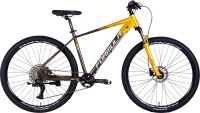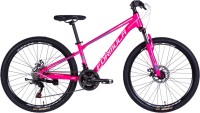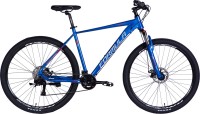Buying a bike: how to choose components
We independently test the products and technologies that we recommend.
We have already given basic recommendations, primarily designed for inexperienced users who are picking up a bike for the first time. In this material, we will look at the problem in more detail and figure out what the frame should be made of, which brakes are better, how big the wheels should be and how, in the end, to choose the perfect bike for yourself.
 |
|
The aluminium frame is the golden mean between steel and carbon: not as heavy as the first, but not as fragile as the second |
Frame material: Who needs carbon fibre?
The modern world bicycle industry produces frames made of three main materials: steel, aluminium and carbon fibre. It may sound a little old-fashioned, but when choosing a bicycle for an amateur, a carbon frame can not even be considered. In fact, it is a wonderful invention of science and combines two important characteristics — lightness and strength. It is indispensable for professional racing bicycles, in which every extra gram of weight can be worth gold. But if you don't plan to break records in the foreseeable future, then you don't need such a frame. The reason is not even the sky-high cost, but the fact that carbon fibre is very sensitive to spot impacts. Careless transportation in the boot of a car or a fall can cause a crack. And if the damage is serious, then the frame will simply have to be thrown away, which can significantly hit the pocket.
On the contrary, the steel frame can easily be trimmed with a hammer, and cracks or fractures can be brewed. And even if it somehow breaks in two - it's not a pity to throw it away and buy a new one. But such bicycles are very heavy and easily deformed. Steel frames are worth looking at if you are looking for an inexpensive bike for a teenager or an urban model. In addition to the low price, there are practically no advantages to this solution.
The most popular option is aluminium. The golden mean between carbon and steel. It boasts a relatively low weight and decent strength characteristics. Most of the bicycles on the market have an aluminium frame, and if you are not a professional racer and not an extreme teenager, then we put a tick in the selection just opposite this item. But for the sake of completeness, we note that if any damage occurs, aluminium is quite difficult and expensive to patch, and if it is done incorrectly, then the frame may simply burst due to heavy loads.
 |
|
The rear shock absorber can noticeably increase the effort spent on driving |
How many shock absorbers are needed
In the 90s, it was not customary to put shock absorbers on bicycles. Except that only the springs under the saddle, if it can be called a shock absorber at all. Today everything has changed dramatically. A saddle with springs has become the greatest rarity, while bicycles with shock absorbers are very common. There are three options on the market: without depreciation, with a damped front fork and two-suspension.
Do not hastily write off bicycles without depreciation. Their main advantage is lightness. If you plan to drive on a flat road, then the shock absorber may be an extra burden. But if we are talking about the roads of an average post-Soviet city, then the shock absorber on the front fork will make driving much more comfortable. With it, you will feel more confident when moving pits and curbs.
As for the two-suspension, they have shock absorbers on the front wheel and on the frame. Does it make sense to have a rear shock absorber? If you are planning extreme trips from the hills or want to look fashionable, then yes. In other cases, it will rather interfere. The rear shock absorber turns the bike into a heavyweight, and the effort spent on riding increases by 20-40%. In addition, in cheap models it performs rather an aesthetic function, with any strong impact it can jam or shift.
Number of speeds
The golden age of the bicycle "Ukraine" has sunk into oblivion, today it is somehow not accepted to ride a two-wheeler without speeds at all. And it is very difficult to find a similar model on the market. But as for the number of speeds, this is exactly the indicator that I would recommend not to bother — there are exactly as many of them as needed for this type of bike.
 |
|
The diameter of the wheels depends on the type of bike, on off-road often install 26 and 29 inch |
Most of the models can boast 20-24 gears, which is quite enough for almost any situation. Models with 27-30 gears are needed for those cyclists who are going to drive on sand, forest and various dirt tracks, but such systems are very difficult to set up and can fail if used incorrectly. Urban models often have a "hidden" system with a small number of gears, which in fact is very convenient and most reliable.
Wheel diameter
It is also not worth lingering on this. Wheels need to be picked up coming out of the bike type. On highways, as well as on hybrid ones, 28-inch ones are traditionally used, and 20—inch ones are used on folding urban ones. These are practically axioms.
The discussion can only be conducted on the topic of choosing wheels for an off-road bike. Five years ago, every cyclist would have answered unequivocally that 26-inch ones are best suited for off-road driving. But in the 2010-2011 season, the velodrome suddenly began to mass-produce mountain bikes "Niners" with 29-inch tyres. And today, many fans of driving outside the city are convinced that the perfect size is 29".
Theoretically, thanks to the large wheels on the Niner, you can drive a long distance faster and more efficiently than on the classic Gornik. But for this, the cyclist will have to put more effort, especially during the ascent to the slopes or acceleration after braking. Fierce opponents of the "niners" claim that the invention of the big wheel is nothing more than a marketing ploy, thanks to which the bike only noticeably heavier. Both formats of mountain wheels have the right to live. But personally, I prefer a smaller one, because it is easier to pack it in the boot of a car.
Frame size
But this is quite an important point that many people lose sight of, which they certainly regret afterwards. When choosing a frame of the right size, the main thing is not whether you reach the pedal with your foot. Much more important is what your back feels while riding.
Different manufacturers have different frame geometries and methods for determining their size, and therefore it is not always easy to calculate a suitable size for yourself. It's good to get on a bike before buying, it's even better to ride it for at least a few days. But if this is not possible, then we have prepared for you an average table of the dependence of the frame size on the height of the cyclist. Please also note that the comfort of driving depends a lot on your anthropological characteristics. If, for example, with a small stature, nature has endowed you with relatively long arms, then you should think about a slightly larger size than provided in the table. The same should be done for girls who really plan to ride a bike in heels.
| Height, cm | Frame size | Frame size, inches |
|---|---|---|
| 130-150 | XS | 13"-14" |
| 145-160 | XS, S | 15" |
| 155-165 | S | 16" |
| 160-175 | S, M | 17" |
| 170-180 | L | 18" |
| 175-185 | L | 19" |
| 180-190 | XL | 20" |
| 185-190 | XL | 21" |
| 185-200 | XXL | 22" |
| 200 and more | XXL | 23" |
Type of brakes
To begin with, we will surprise you with the fact that there are quite a lot of models on the market without brakes. These are, in particular, bicycles for racing on the track, in which braking is possible only by gradually slowing down the movement, as well as special bicycles for extreme stunts, on which they brake due to the friction of the sole of the shoe on the wheel.
 |
|
Do not underestimate the importance of choosing the right frame — the comfort of riding depends on it |
But most of them are still equipped with brakes, which are actuated by the traditional method — the cyclist pulls the brake handles on the steering wheel with his fingers. But how the wheel stops at the same time depends on the system itself. If this is a rim mechanism, then the wheel stops due to the friction of the V-shaped pads directly on the rim. If the disc wheel stops the brake disc, squeezing it with special pads on both sides.
Disc brakes have long been used in cars and motorcycles, and the development of technology in the last few years has made it possible to adapt the system to bicycles. Now they are not used except on high-speed highway models. The only thing in which the disk system is inferior to the rim is in lightness. But cheap mechanical disc brakes quickly fail and it is very difficult to repair them yourself. If you have enough money for a bike with a high—quality hydraulic disc system, it makes sense to choose one. Then you can enjoy all the advantages of new braking technologies, and this is a soft stop, and the independence of braking quality from weather conditions.
V-like brakes are suitable for those who like simplicity and reliability. They are very easy to maintain, but their disadvantage is sliding and reduced productivity during rain or driving through a swamp.
Above, we have listed the main questions that should be answered when selecting the "perfect" bike. In fact, there are more criteria, including: colour, boot availability, locking of the amortized fork, year of manufacture, weight and others. But the rest are rather of a secondary nature. The most important thing is to determine these parameters.
See also:
Rating of the most popular bicycles
It is based on comprehensive statistics of the popularity of a particular model among the Internet audience.
What should your bike be like?
On the eve of the summer season, it's time to transfer from public transport to a "two—wheeled friend".
Articles, reviews, useful tips
All materials
















